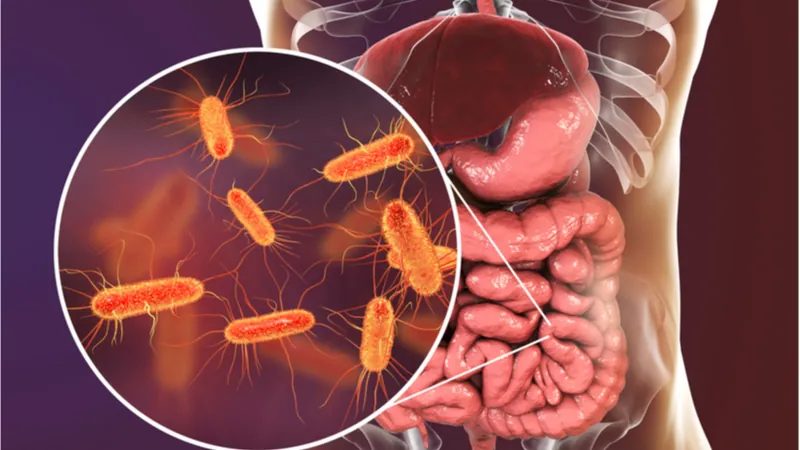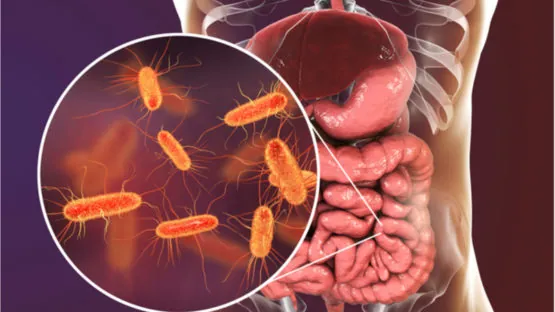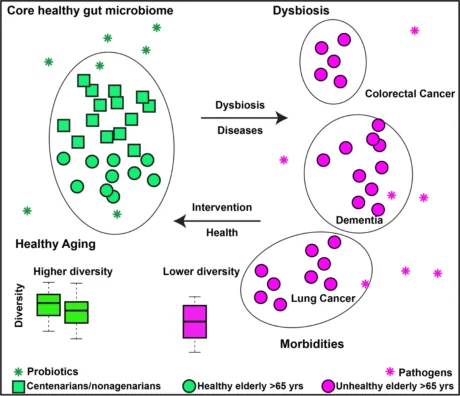A new study has outlined the age-related changes of the gut microbiome, showing a correlation between the microbiome’s composition and overall health.
The gut microbiome
The microbiome describes a varied community of bacteria, archaea, eukarya, and viruses that inhabit our gut. The four bacterial phyla of Firmicutes, Bacteroidetes, Proteobacteria, and Actinobacteria comprise 98% of the intestinal microbiome.
The microbiome community is a complex ecosystem whose activity regulates a number of functions in the gut and interacts with the immune system and energy metabolism. The beneficial bacteria in our gut also help to prevent the growth of harmful bacteria, protect us from invasive microorganisms, and help to maintain the integrity of the intestinal barrier.
One of the microbiome’s more important activities is to facilitate energy production and metabolic function, which it achieves by the creation of short-chain fatty acids (SCFAs) and their conjugate bases (acetate, propionate, and butyrate). A number of bacteria, including Faecalibacterium prausnitzii, Roseburia faecis, Anaerostipes butyraticus, Ruminococcaceae, and Christensenellaceae, break down fiber and ferment it to make these SCFAs, which are then used as an energy source for the microbiome and by gut membrane cells such as colonocytes. This, in turn, supports the integrity of the intestinal barrier and stimulates the inflammasome pathway in gut homeostasis [1].
The gut microbiome helps facilitate immune function and development, and studies have shown that when the microbiome is absent, such as in animals kept in a sterile environment, the immune system does not develop and mature properly [2]. Gut bacteria such as Candida albicans and Citrobacter rodentium also help with pathogen control by activating T cells and summoning neutrophils and other immune cells. Bacteroides fragilis and Clostridium help to regulate inflammation by inducing the differentiation of regulatory T cells (FoxP3-positive) and the production of interleukin-10 and transforming growth factor β [3].
Health and diversity of the gut microbiome
There have been a number of recent studies investigating the microbiomes of older people compared to those of younger people. In general, the diversity of the gut microbiome declines with age, as do the numbers of beneficial bacteria, while the populations of potentially harmful bacteria, such as those of the Firmicutes phylum, often increase. These age-related changes could be due to changes in diet, increased use of medication for age-related diseases, reduction of physical activity, and age-related changes to the body in general.
There is a strong correlation between decreased microbiome diversity and declining health, and microbiome health has been associated with a number of metabolic conditions, such as type 2 diabetes and obesity. There is also considerable evidence that changes to the microbiome that cause loss of gut homeostasis (a state of balance) are linked to the chronic age-related inflammation known as ‘inflammaging’; indeed, the emerging hypothesis is that the origin point of inflammaging could be the microbiome. This loss of homeostasis is linked to loss of gut membrane integrity (leaky gut), frailty, and neurodegenerative disorders such as Alzheimer’s disease and Parkinson’s disease.
A new study published in the journal Aging builds on our understanding of how the microbiome and its diversity impacts longevity and health [4].
Kong and colleagues examined the gut microbiome of a cohort of healthy, long-living Chinese individuals including nonagenarians (90-99 years old) and centenarians (≥100 years old) in Dujiangyan, Sichuan, China. They found that this cohort of long-living people possesses a more diverse gut microbiota than younger adults, contradictory to conventional views. They also found that a group of bacteria, members of which are known short-chain fatty acid (SCFA) producers such as Clostridium cluster XIVa, are enriched in the long-living Chinese.
To verify their discovery, they analyzed an independent data set from a cohort of an Italian group. Consistently, the long-living Italians also had more diverse gut microbiotas than the younger group. When they combined the Italian and the Chinese data sets, they found that although the gut microbiota structures are significantly different, probably due to the differences in diet, genetics and environment, 11 of the top 50 bacterial features that differentiate the long-living individuals from the younger group were shared. Again, these features included the greater microbiome diversity and several enriched OTUs (operational taxonomic units) related to SCFA production. In a follow-up study, Kong and colleagues showed that the greater gut microbiome diversity in the long-living people was also observed in two more independent cohorts: one from Jiangsu, China and the other from Japan.
These studies clearly revealed that more diverse and balanced gut microbiotas are present in healthy, long-living people, whereas disturbed gut microbiotas with dysbiosis are observed in the elderly who suffer from different comorbidities. We thus hypothesize that modulation of the gut microbiome (e.g., via diet, probiotics) to maintain a healthy gut microbiome will promote healthy aging. We further hypothesize that modulation of the disturbed gut microbiome to a healthy one in the elderly with chronic diseases will alleviate their symptoms and increase the quality of their lives.
Figure 1. Working hypothesis of gut microbiome and healthy aging.
Conclusion
The researchers conclude that longer-living healthy people tend to have more diverse and balanced gut microbiomes than those of the unhealthy elderly. This certainly appears to be the case in similar studies, and their suggestion that the gut microbiomes of unhealthy people might be adjusted towards those of healthy, long-lived people has merit. If diet or probiotics could be used to restore the balance of the gut microbiomes of older people who suffer from ill health, this may go some way towards improving their health and quality of life.
This study also makes a strong case for promoting the health of your own microbiome by eating a balanced diet rich in fiber to provide nutrition to the beneficial bacteria living in your gut. A diet rich in plant matter is a good start, so consider eating plenty of fruits, vegetables, and other fibrous foods to keep your microbiome in good health.
Literature
[1] Macia, L., Tan, J., Vieira, A. T., Leach, K., Stanley, D., Luong, S., … & Binge, L. (2015). Metabolite-sensing receptors GPR43 and GPR109A facilitate dietary fibre-induced gut homeostasis through regulation of the inflammasome. Nature communications, 6, ncomms7734.
[2] L., & Mazmanian, S. K. (2009). The gut microbiota shapes intestinal immune responses during health and disease. Nature Reviews Immunology, 9(5), 313.
[3] Atarashi, K., Tanoue, T., Oshima, K., Suda, W., Nagano, Y., Nishikawa, H., … & Kim, S. (2013). T reg induction by a rationally selected mixture of Clostridia strains from the human microbiota. Nature, 500(7461), 232.
[4] Feilong Deng, Ying Li, Jiangchao Zhao (2019). The gut microbiome of healthy long-living people. doi.org/10.18632/aging.101771.




